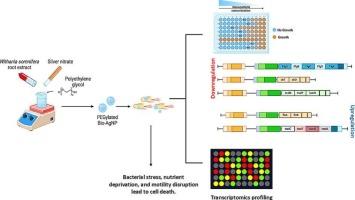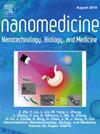Withaferin A和Withanolide A介导的银纳米颗粒靶向大肠杆菌的细菌运动、代谢和应激适应
IF 4.6
2区 医学
Q2 MEDICINE, RESEARCH & EXPERIMENTAL
Nanomedicine : nanotechnology, biology, and medicine
Pub Date : 2025-07-23
DOI:10.1016/j.nano.2025.102846
引用次数: 0
摘要
以藜草根提取物为原料合成了生物源银纳米粒子(Bio-AgNPs),并对其抗菌性能和生物安全性进行了评价。LC-MS确认了包括Withaferin a在内的关键的Withaferin a。纳米颗粒在446 nm处具有紫外可见峰,晶核尺寸为~ 15.65 nm,流体动力学直径为~ 134.85 nm, zeta电位为- 25.29 mV。Bio-AgNPs对大肠杆菌K12具有较强的抗菌活性,mic在156.25 ~ 312.5 ppm之间,对AgNO₃有较好的抗菌效果。RNA-seq分析显示鞭毛基因(flgD, flgG, fliC),麦芽糖转运蛋白(malK, malF, lamB)和柠檬酸盐代谢(citT, citD)下调,表明运动和营养摄取受损。金属外排(cusF, cusB)和电子传递(fixA, fixB)基因的上调反映了氧化应激反应。WI-38和HEK-293细胞的细胞毒性试验显示,在156.25 ppm浓度下,细胞存活率为80%。这些发现支持生物agnps作为生物相容性的植物源抗菌剂对革兰氏阴性菌有效。本文章由计算机程序翻译,如有差异,请以英文原文为准。

Withaferin A and Withanolide A-mediated silver nanoparticles target bacterial motility, metabolism, and stress adaptation in E. coli
Biogenic silver nanoparticles (Bio-AgNPs) were synthesized using Withania somnifera root extract and evaluated for their antimicrobial and biosafety profiles. LC-MS confirmed key withanolides, including Withaferin A. The nanoparticles exhibited a UV–Vis peak at 446 nm, a crystalline core size of ∼15.65 nm, a hydrodynamic diameter of ∼134.85 nm, and a zeta potential of −25.29 mV. Bio-AgNPs showed potent antibacterial activity against Escherichia coli K12, with MICs between 156.25 and 312.5 ppm and superior efficacy to AgNO₃. RNA-seq analysis revealed downregulation of flagellar genes (flgD, flgG, fliC), maltose transporters (malK, malF, lamB), and citrate metabolism (citT, citD), indicating impaired motility and nutrient uptake. Upregulation of metal efflux (cusF, cusB) and electron transport (fixA, fixB) genes reflected oxidative stress response. Cytotoxicity assays on WI-38 and HEK-293 cells showed >80 % viability up to 156.25 ppm. These findings support Bio-AgNPs as biocompatible, plant-derived antimicrobials effective against Gram-negative bacteria.
求助全文
通过发布文献求助,成功后即可免费获取论文全文。
去求助
来源期刊
CiteScore
11.10
自引率
0.00%
发文量
133
审稿时长
42 days
期刊介绍:
The mission of Nanomedicine: Nanotechnology, Biology, and Medicine (Nanomedicine: NBM) is to promote the emerging interdisciplinary field of nanomedicine.
Nanomedicine: NBM is an international, peer-reviewed journal presenting novel, significant, and interdisciplinary theoretical and experimental results related to nanoscience and nanotechnology in the life and health sciences. Content includes basic, translational, and clinical research addressing diagnosis, treatment, monitoring, prediction, and prevention of diseases.

 求助内容:
求助内容: 应助结果提醒方式:
应助结果提醒方式:


